Real-World 600V Transformer Install Tips from a Master Electrician
Use Coupon Code “Speedyshark10” for 10% Off Your Next Rack-A-Tiers Order!
Everyone thinks they know best, but sometimes you don’t realize you could be doing a job differently until you see the methods and tools used by others. We had Bryan (@speedyshark.electrician) walk us through a recent transformer install he did to show how some smart tools you might not know about can be real game-changers.
Get to Know Bryan
 My name is Bryan Johansson, @speedyshark.electrician on Instagram. I’m a commercial and industrial electrician who dabbles in residential work as well. I’m going to talk about a mechanical upgrade where we had to install a transformer to provide 600V for controlling some heat pumps.
My name is Bryan Johansson, @speedyshark.electrician on Instagram. I’m a commercial and industrial electrician who dabbles in residential work as well. I’m going to talk about a mechanical upgrade where we had to install a transformer to provide 600V for controlling some heat pumps.
Prepping the Jobsite: Working with Unistrut
 First, we had to get into the main electrical room and figure out which breaker is serving that area so that we can intercept the 208V feed that’s coming in and get it into a transformer. To do this, I tend to use my Fluke tester to make sure that the circuits that I’m messing with are dead.
First, we had to get into the main electrical room and figure out which breaker is serving that area so that we can intercept the 208V feed that’s coming in and get it into a transformer. To do this, I tend to use my Fluke tester to make sure that the circuits that I’m messing with are dead.
 Then, what we do to get started is build the infrastructure, which is basically a strut rack in the ceiling above the T-bar. The T-bar is a complete nuisance, but luckily, the general contractor removed a bunch of the framing for it, so we were able to get up with our ladders and build it. It’s basically Unistrut. We use Rack-A-Tiers hardware for everything. That’s what’s most readily available at the wholesaler, and it’s good quality. We get a bunch of hardware for the Unistrut racking. It depends on the weight that you’re holding and what size of the hardware you’re going to use.
Then, what we do to get started is build the infrastructure, which is basically a strut rack in the ceiling above the T-bar. The T-bar is a complete nuisance, but luckily, the general contractor removed a bunch of the framing for it, so we were able to get up with our ladders and build it. It’s basically Unistrut. We use Rack-A-Tiers hardware for everything. That’s what’s most readily available at the wholesaler, and it’s good quality. We get a bunch of hardware for the Unistrut racking. It depends on the weight that you’re holding and what size of the hardware you’re going to use.
Keep Shrapnel Out of Your Panels
 We got that set up, and then we were able to run the incoming tech into the primary side of the transformer from the MDP. The main thing that we have to do is make sure that we don’t get any shards in our equipment, which is a huge thing because it’s all copper windings in a transformer, and you don’t want shrapnel in them. Because of the nature of the tech we had to run over, we had to use the Dirt Bag to cut holes. We also used the Greenlee KO kit to cut the proper sizes.
We got that set up, and then we were able to run the incoming tech into the primary side of the transformer from the MDP. The main thing that we have to do is make sure that we don’t get any shards in our equipment, which is a huge thing because it’s all copper windings in a transformer, and you don’t want shrapnel in them. Because of the nature of the tech we had to run over, we had to use the Dirt Bag to cut holes. We also used the Greenlee KO kit to cut the proper sizes.
Keep Panels Clean with Dirt Bag
Bending Wire and Conduit for a Transformer Install
 One thing we had to observe while we were doing it was that all specced to be wet connectors, so all of the cables were going into LBs. And because of that, we had some really tight 90s. Doing that by hand can be pretty cumbersome and hard on the wrist after messing with that for a long time. That’s where I bring in the Bulldog Bender. It seems to always help the process and eliminate fatigue. We use that to get the cable ventured into the transformer.
One thing we had to observe while we were doing it was that all specced to be wet connectors, so all of the cables were going into LBs. And because of that, we had some really tight 90s. Doing that by hand can be pretty cumbersome and hard on the wrist after messing with that for a long time. That’s where I bring in the Bulldog Bender. It seems to always help the process and eliminate fatigue. We use that to get the cable ventured into the transformer.
Then we had to run over some branch circuit conduits that came from another panel. Kind of unrelated, it was just asked for by our general for a couple of general-use plugs that were near the panel and the transformer. I actually used the Hoppy Bender with the three-quarter-inch EMT. I found it really nice because it’s three set angles, so it takes out a bit of the guesswork.
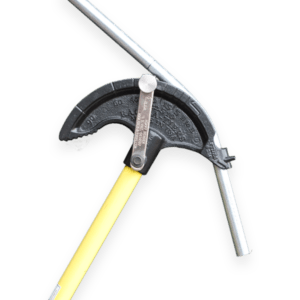 I had an apprentice on-site who hadn’t spent much time bending pipes. So being able to set the angles was really helpful for him because, unless you do it a ton, bending pipe can be really time-consuming. It really helped speed everything up for him, which helps me because the better we look, the more money we should make.
I had an apprentice on-site who hadn’t spent much time bending pipes. So being able to set the angles was really helpful for him because, unless you do it a ton, bending pipe can be really time-consuming. It really helped speed everything up for him, which helps me because the better we look, the more money we should make.
Simplify Bending with Hoppy Bender
Pulling Wires Into the Panel
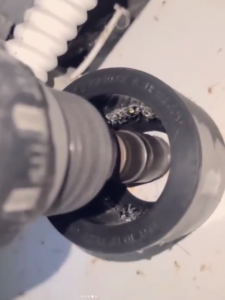 All the infrastructure was built, so we got ready to run the branch circuits, which meant pulling the wires over from one of the panels in the electrical room. To run wire from the panel to the branch circuit areas, we needed to enter our conduit into the panel, which meant cutting smaller holes. To help with that, we used the Chip Catcher.
All the infrastructure was built, so we got ready to run the branch circuits, which meant pulling the wires over from one of the panels in the electrical room. To run wire from the panel to the branch circuit areas, we needed to enter our conduit into the panel, which meant cutting smaller holes. To help with that, we used the Chip Catcher.
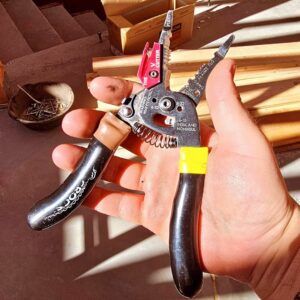 It was just 12-gauge wire because they were general-use receptacles. So, I pulled out my trusty Croc’s. I use the Croc’s Jr. with the V-Cutter because I like being able to cut into non-metallic wire with the V-Cutter. It slides up the sheaths really nicely. We got those terminated and into the panel, but we just capped them with marrets because we didn’t want to liven up anything yet.
It was just 12-gauge wire because they were general-use receptacles. So, I pulled out my trusty Croc’s. I use the Croc’s Jr. with the V-Cutter because I like being able to cut into non-metallic wire with the V-Cutter. It slides up the sheaths really nicely. We got those terminated and into the panel, but we just capped them with marrets because we didn’t want to liven up anything yet.
After that, we dealt with the secondary side of the transformer, which was going into the new panel. The incoming was on a 208V breaker, and then it was coming out as 600V. So, it was a step-up transformer so that we could run 600-volt over to the heat pumps.
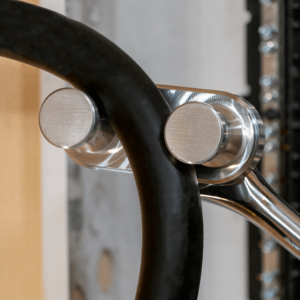 The secondary side was going to be put in with conduit. That was just general two-and-a-half-inch conduit with wet fittings. So again, with the LBs, you can struggle quite a bit with those. The combination of the Bulldog Bender and the Bend-All takes care of hitting the bending angles. You also have to pay attention to the bend radius of the cables, which means it needs to be nice and smooth. I got my Bulldog bender with smooth dowels, so it doesn’t cut into the cable, which is quite nice. That way, you don’t have to tape anything up.
The secondary side was going to be put in with conduit. That was just general two-and-a-half-inch conduit with wet fittings. So again, with the LBs, you can struggle quite a bit with those. The combination of the Bulldog Bender and the Bend-All takes care of hitting the bending angles. You also have to pay attention to the bend radius of the cables, which means it needs to be nice and smooth. I got my Bulldog bender with smooth dowels, so it doesn’t cut into the cable, which is quite nice. That way, you don’t have to tape anything up.
Explore Our Wire Bending Tools
Obviously, you’re still going to check if there’s any damage to the cable. But it kind of eliminates the worry.
Next, we pushed it through the conduit from the secondary side of the transformer into the new panel. And that’s basically that panel’s feed done. So now we have a 600-volt panel in the main area. Where we can run 600-volt circuits to the heat pumps or whatever we want, based on what we’re feeding that panel with as far as the ampacity.
The Best Knives for Electricians
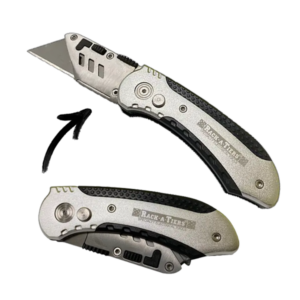 Anyhow, then we had to schedule a shutdown. We had to go in after hours to get the breaker into the MDP. It was quite a large breaker. There was a lot of work for it. When I’m doing those cut-ins, I use two different knives. I have what’s called a dismantling knife by Knipex, and then I also have the Rack-A-Tiers Folding Utility Knife. It’s kind of like an Olfa knife, but with changeable blades on it. I like both of them.
Anyhow, then we had to schedule a shutdown. We had to go in after hours to get the breaker into the MDP. It was quite a large breaker. There was a lot of work for it. When I’m doing those cut-ins, I use two different knives. I have what’s called a dismantling knife by Knipex, and then I also have the Rack-A-Tiers Folding Utility Knife. It’s kind of like an Olfa knife, but with changeable blades on it. I like both of them.
The Rack-A-Tiers knife is really sharp. My dismantling knife has been used so much, it’s a little duller. It actually can be advantageous sometimes to not have it super sharp. Especially when using aluminum. Because it creates little craters as you’re cutting. If you cut too deep, it can cause arc spots or anything of the sort. So yeah, I use those and we get those cables into the MDP, bolt on the new breaker, and now we have our 600-volt panel in the area for the heat pumps.
Check out the Folding Utility Knife
Making Every Job a Little Smoother
Huge thanks to Bryan (@speedyshark.electrician) for taking us through his transformer install and showing how the right tools can make all the difference. It’s cool to see how a few smart choices can turn what might be a long, frustrating job into something smooth and efficient. From clean cuts to perfect bends, having the right gear on hand keeps the work flowing and the results solid. It just goes to show that the right tools really do make every job a little easier.